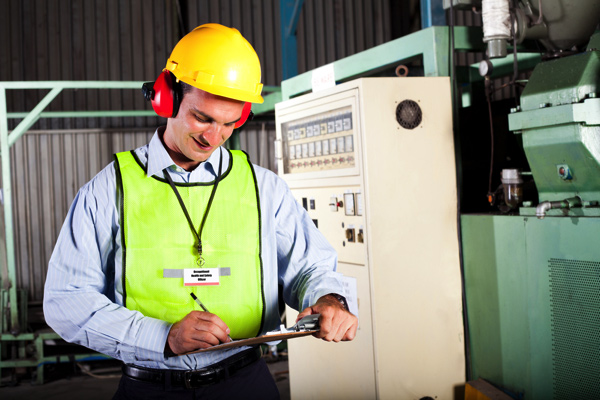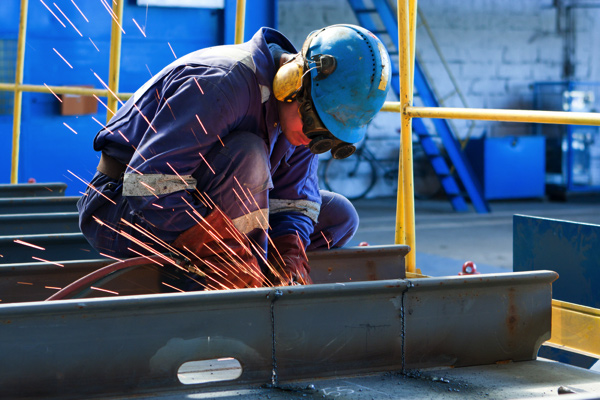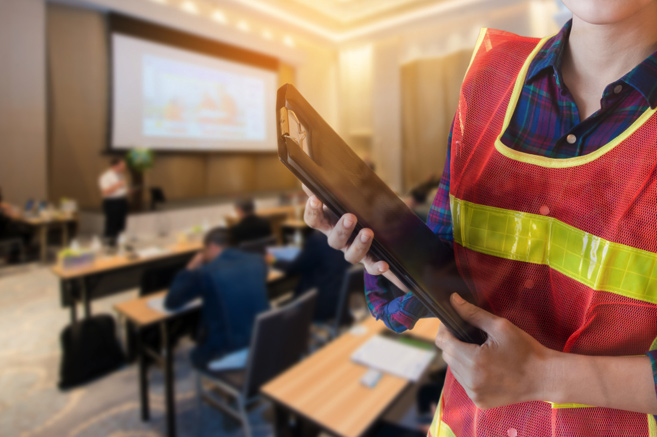The manufacturing industry is the beating heart of any strong economy. To keep that heart beating, it is vital for companies to keep their workers safe. Safe workers are happier, healthier, and more productive. Naturally, manufacturing processes involve a large number of hazards. Health and safety regulations have improved immensely over the last century, but accidents can and do still happen every day. What are the major risks? How can you prevent them? And are you doing enough to keep your workers safe? This list presents five top safety hazards that known in the manufacturing industry. They aren’t the only ones, but they are critical dangers known to every responsible manufacturing boss.

Falls are an ever-present danger in the manufacturing industry. Working on high platforms, cherry pickers, ladders, or any other raised area poses a personnel risk. Most industries recognize the need for hard hats and fall-protection gear, however, falls still account for the leading cause of injury and death among American workers. Not only is there is a chance of serious injury which could mean time off work, but there is also a risk to workers’ lives.
It is crucial that workers receive regular training to understand signals from the ground, use any protective gear or equipment necessary, and avoid complacency. Attitude is crucial, and bosses must work to ensure safety really does come first. OSHA has a comprehensive list of regulations that can help to mitigate the risk of falls.
One thing that can lead to slips and falls is when the workspace is left untidy and unclean. Hiring an industrial cleaning service to regularly clean the area can significantly help to prevent this. For an idea of the service that could be provided to your manufacturing business, take a look at idealcleaning.co.uk. They can provide either a one-off or a regular service that covers everything from the cleaning of machinery, spills and even all your vents, cladding and light fittings. Leaving your premises in the capable hands of industrial cleaners will help to ensure you meet the necessary safety standards in the workplace.
Combustion and welding equipment are examples of controlled flames that can be present in a manufacturing environment. These are critical parts of many manufacturing processes, but what happens when those fires get out of control? Lives are put at risk, and that means businesses are at risk, too. Manufacturing environments should be fitted with smoke detecting devices and sprinklers to tame uncontrolled blazes when required. Workers must be provided with and trained to use fire extinguishers but also be able to evacuate the building if needed. A good factory will have multiple, well-marked fire exists and carry out fire drills on a regular basis to ensure the safety of its workers.
Although manufacturing equipment may seem like the most apparent fire hazard in the industry, bosses should also be careful of lighting and electrical systems. These are the most common causes of fire in domestic environments and pose an additional risk of electrocution if not adequately insulated. Safe equipment plays a vital role in ensuring a safe work environment. For example, choose from a range of tested, reliable hot melt glue guns that can reduce the risk of injury to operators.

Machinery is a key risk factor that is arguably most prevalent in the manufacturing industry. Forklift trucks account for a large number of accidents in the industry. These include a risk to human life, a chance of injury, and the potential to damage goods and materials. Experienced bosses often point to pressure as a leading cause of hazards related to forklift truck driving. Pressure to meet unreasonable deadlines can cause workers to cut corners, driving with a load that is too large or not keeping a safe distance from racking or machinery. It is imperative that safety comes first, and that supervisors make reasonable expectations of their subordinates. Additionally, even when expectations are reasonable, bosses must supervise and train workers to ensure they aren’t loitering during a shift and later rushing to meet a deadline.
All sorts of machinery are present in the manufacturing industry. Much of this equipment is made to handle hard materials, such as wood, metal, and plastic. Naturally, the effects of this equipment on human flesh can be devastating. Properly guarded machinery helps to keep workers safe, but it is also critical to train workers properly, with regular re-testing and re-training if needed. This will ensure the safe operation of heavy machinery and a safe work environment. Only employees trained and certified in the use of specific machinery should operate the equipment.
Confined spaces, such as a vat or tank, present a risk of oxygen depletion. Education is vital in ensuring safe practices are employed working in confined spaces, as the symptoms of suffocation can come about suddenly. The worker may be unable to react in time or be impaired by the lack of oxygen. As with all potentially hazardous work, it is strongly advisable for workers to be in pairs, with one employee removed from the danger. With this system, there is always one employee who can assist or, at the very least, send a quick request for help should a problem arise.
Beyond this, workers must understand what qualifies as a confined space to correctly apply any training. A clearly marked workplace helps to maintain safety on this count and many others. Floor managers should keep additional equipment that might be used in case of a critical situation involving a confined space, such as a harness or face mask, nearby for easy access if required. Although it is not necessary to train all workers in the use of such equipment, it is advisable for those working in confined spaces to have a basic understanding of it.

Many industries require that workers manage and handle hazardous chemicals daily. These are often crucial elements in the manufacturing process, but workers must be trained to use them correctly and safely. Examples of dangerous chemicals include caustic cleaning solutions, battery acid, and flammable substances such as ethanol. First and foremost, the workers using these chemicals must know how to move, load, and operate processes using these chemicals safely. This will ensure safety in normal, predictable use cases.
However, there is always a chance that something will go wrong in unforeseen circumstances. For this reason, bosses should have workers who are trained in treating exposure to dangerous chemicals. It is also vital that, if needed, procedures are in place to evacuate the premises for specialists to come in and clear the problem. Keeping basic safety instructions nearby is an excellent way to aid workers in their decision-making when exposed to a dangerous chemical. For a good business practice, as well as safety, all dangerous chemicals should be labeled clearly and visibly so that, in the case of accidental spills, workers and paramedics can identify the hazard.
Every workplace has its hazards, but the manufacturing industry poses a higher risk of injury than many other modern work environments. Despite this, it is possible to run a safe manufacturing operation if the correct training and education are provided to employees. A big part of keeping workers safe is ensuring they are focused and happy when completing the task at hand—this means providing the right tools and training for the job.
 About the Author:
About the Author:
Casey Heigl is a packaging industry insider. As the Marketing Manager for Hotmelt.com and Gluegun.com she has extensive knowledge of hot melt applications, vendors, and industry trends. Casey enjoys sharing her unique perspective with her blog writing. When she isn’t researching and writing articles she is spending time with her family and crafting with professional glue guns!
In this episode, I sat down with Beejan Giga, Director | Partner and Caleb Emerson, Senior Results Manager at Carpedia International. We discussed the insights behind their recent Industry Today article, “Thinking Three Moves Ahead” and together we explored how manufacturers can plan more strategically, align with their suppliers, and build the operational discipline needed to support intentional, sustainable growth. It was a conversation packed with practical perspectives on navigating a fast-changing industry landscape.